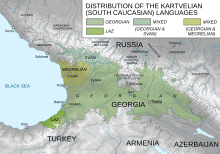Lasic language
| Lasisch | ||
|---|---|---|
|
Spoken in |
|
|
| speaker | approx. 22,000 - 250,000 | |
| Linguistic classification |
|
|
| Official status | ||
| Official language in | - | |
| Language codes | ||
| ISO 639 -1 |
- |
|
| ISO 639 -2 |
cau |
|
| ISO 639-3 | ||
The Lasic language ( Lasish : ლაზური ნენა lazuri nena ; Turkish Lazca , Georgian ლაზური ენა ) is a South Caucasian language spoken by the Lasen people in the extreme northeast of Turkey and southwest Georgia . The language is closely related to Mingrelian .
The Turkish dialect in the Black Sea region is also known colloquially as "Lasisch" ( lazca ).
Regional distribution

Regionally, the language is spoken in Rize , Samsun , Trabzon , Tonya, Pazar (Atina), Ardeşen (Artaşeni), Çamlıhemşin (Vijadibi), Fındıklı (Viзe), Arhavi (Arxabi), Hopa (Xopa) and Borçka . Due to the migration of the Lasen there are also speakers in villages in the provinces of Artvin , Bartın , Zonguldak , Sakarya , Kocaeli , Bolu . In Georgia, Lasish is spoken in Adjara . There are also speakers in Belgium , France , the USA , Austria and Germany .
Linguistic characteristics
The hallmark of this language is a very complex sound system with a large number of different consonants . There are more Turkish and Greek loan words than in Mingrelian.
font
Lasian intellectuals in Turkey developed a script based on the new Turkish alphabet . Local newspapers in Arhavi appear with this font . In Georgia, the Georgian alphabet is used for Lasic .
Political situation
initial situation
Over time, Lasic has been influenced by the Turkish and Greek languages , which can be attributed to common settlement areas. The fact that there was no uniform Lasic language teaching in the Lasi area of Turkey means that the dialects differ from place to place.
Lasisch is not an official minority, official or lingua franca. It is only used by the Lasi minority .
There is no possibility of Lasic language education in schools. Many Lasen recognize the Turkish language as an official language , but would welcome additional lessons in their language. The latest educational policy enables students in grades 5–6 to choose Lasisch as electives.
distribution
Lasisch-speaking musicians such as Birol Topaloğlu (* 1965) and Kâzım Koyuncu (1971–2005) have reached a wide audience with their songs. In addition, Lasic websites, books, newspapers and radio broadcasts aim to generate interest in this language. “Lasic rock music” is very popular.
literature
- Heinz Fähnrich (Ed.): Kartwelsprachen. Old Georgian, New Georgian, Mingrelian, Lasisch, Swanian . Reichert, Wiesbaden 2008, ISBN 978-3-89500-653-1 .
- Georgij A. Klimov: Introduction to Caucasian Linguistics . Buske, Hamburg 1994, ISBN 3-87548-060-0 (from the Russian by Jost Gippert).
Web links
- Laz. In: Languages of the World, Ethnologue ,
- The Lasic language. (PDF; 194 kB)
- (Turkish / Lasisch)
- Lasic forum
Individual evidence
- ↑ ISO 639-3 lzz 2014. Languages of the World . In: Ethnologue
- ↑ Kazim Koyuncu and Lazish Music ( Memento November 11, 2009 in the Internet Archive ) In: lazebura.net
- ↑ Ildikó Bellér-Hann: Turkish region. James Currey Publishers, 2001, ISBN 978-0-85255-279-7 , p. 11. Limited preview in Google Book Search
- ↑ Lazlar 2 / Sayfa 60 ( Memento from September 3, 2009 in the Internet Archive ) In: turkleronline.com
- ↑ Ashley Carter: Musician Tries to Preserve Heritage - The Purdue Exponent November 6, 2001 ( January 17, 2007 memento in the Internet Archive ) In: sfworldmusicfestival.org
